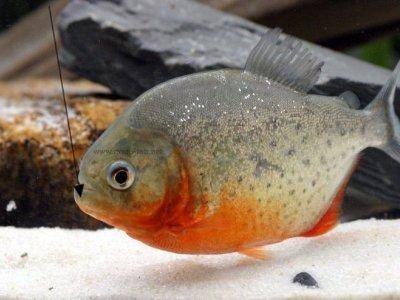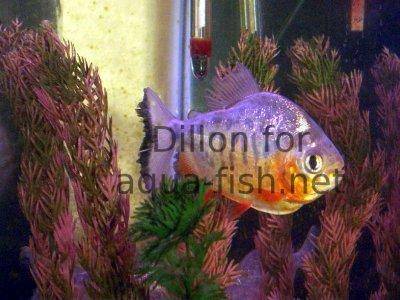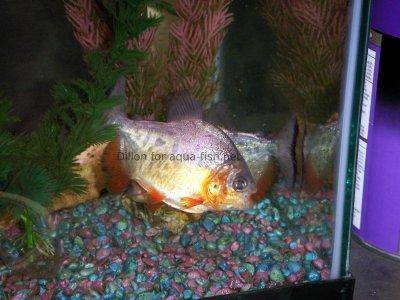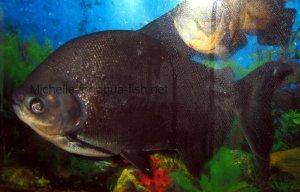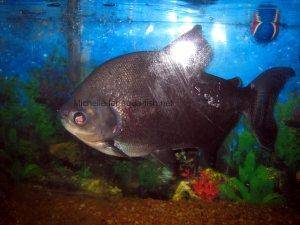The Pacu Fish - Guide on care, Pictures & Forum
Quick links - Answers
Brief Description
This page is devoted to raising Pacu fish in fish tanks, or garden ponds, and is also a place for sharing experiences and asking questions! We'd love to hear about your Pacu's, so before leaving this page send us your story, please - use a form that is at the bottom of this page for this purpose. You should also visit following pages: Black pacu - Colossoma macropomum profile with forum and Red bellied pacu - Piaractus brachypomus profile and forum.
Pacu the charmer
One of the first fish I ever owned was a Red Belly Pacu. I first noticed them because of their natural look and exciting swimming behaviour. Especially after a meal, they would chase each other around the tank almost as if they were playing a game of tag. Moving through the water you can really see that they are powerful swimmers and enjoy room to play with other Pacus in the tank. When first introduced into the tank you might notice their skittish behaviour when it comes to sudden movements around the tank. Much like their piranha cousins, Pacus like rocks, plants and other décor to hide behind and feel less vulnerable.
The difference between Pacu and Red belly Piranha
Often times, especially in the juvenile stage, the Red Belly Pacu is confused with their cousin the Red Belly Piranha. You might see Red Belly Piranhas sold as Pacus because of the inability to differentiate between the two fish. In the two pictures below you can see the simple way to tell the difference.
Red belly Piranha
You can see the larger under bite and bigger lower jaw of the piranha.
Red Belly Pacu
Although this is a younger fish than the piranha above, you can see he contains the same colours, and has body shape similarities.
Tank mates
Tank mates can be tricky with the Red Belly Pacu. They are not considered a highly aggressive fish but they will eat other small fish if it can fit in their mouth. They will outgrow most other fish before too long. It is not uncommon to see your pacu get along with a certain fish for long periods of time, even years, only to find a missing fish and a full belly with your pacu. Cichlids are often thought to be a suitable tank mate, but many varieties of cichlids are just too aggressive to keep with pacus. Going with larger peaceful fish is your best bet.
Feeding
Pacus are known to be herbivores, so obviously keeping live plants will not last very long. Fake plants will last much longer, and are much easier to take care of. I find my pacus are the least picky fish I have ever owned as far as food goes. I have heard Pacu feeding stories containing lettuce, chicken, goldfish feeders, fish flakes, fish pellets and shrimp seems to be a favourite when they are large enough. I love how high energy pacus get when it is feeding time. Even after the food is gone pacus love to play and chase like in this photo below. You can see they like to circle furiously around each other with their mouths open wide.
It is not a small fish
Many times people go to pet stores and see quarter sized fish having no idea how large or FAST pacus will grow. They buy 3-4 for their 10 gallon (~38 litre, 8.33 Imperial gallon) tank and within 3 months they are back at the pet store buying a larger tank. These guys grow into giants! If given the proper tank setup you can see Pacus grow into a 2 foot long (60cm) fish. This means at some point you are looking at a 250 gallon (~946 litres, 208 Imperial gallons) aquarium. Keep that in mind if you have, or are going to have some of these potential monster fish. And pacus size isn’t the only thing that is big. The lifespan of these guys can be 12-14 years.
Tank requirements
So as mentioned, you will need about a 250 gallon (~946 litres, 208 Imperial gallons) tank, so get ready before you buy this specie, and a suitable solution regarding filtration is to use “usually more than one”. The temperature should be about 79°F (26°C), otherwise these fish may become prone to diseases. If the temperature in a fish tank or pond exceeds recommended value, your Pacu may be facing lower levels of oxygen in water which isn't ideal. It is also very important to keep the temperature very stable and by changing it too rapidly (rapidly is very relative word and for Pacu rapidly is the same as for other fish slowly) you fish might die.
Pacu the re-decorator
Once they are big they can start to move some stuff in the aquarium around. From knocking heaters off, to pushing rock formations down, when these guys get moving they can do some damage. It is a good idea to make sure all your decorations are set firm and stable for your sake and the pacu’s. Blocking the heater with a rock or driftwood will make sure your pacus don’t get hurt, and make sure your heater doesn’t break.
Breeding
They probably will not breed in a home tank. Most of them come from large farms, where they live in huge ponds. Pacu's lay thousands of eggs and they will try to eat them right away, so if by any chance you have a giant tank and they breed, separate the parents from the eggs.
My favourite fish
They are a truly enjoyable fish. Take time to enjoy the different habits you will see your Pacus develop. Their interaction with each other is what I find to be the most entertaining. Unlike many other fish that seem “unsocial,” pacus will surely grow on you and be one of your favourite fish in the aquarium.
Pictures of the Pacu species
Feel free to visit Pacu Care Basics at firsttankguide.net too!







